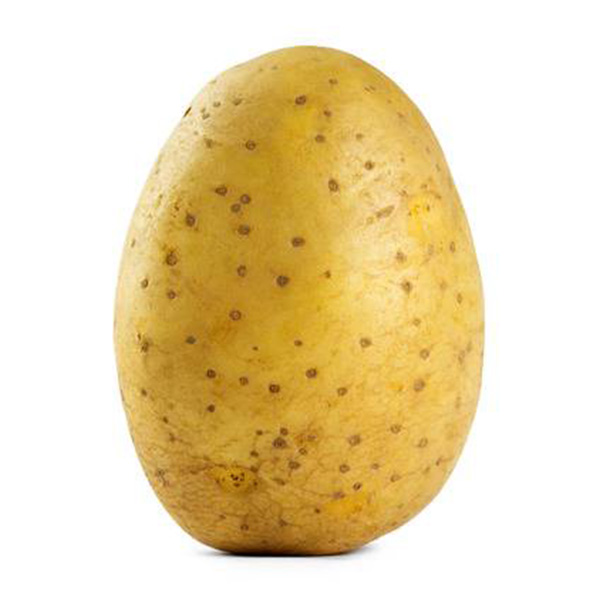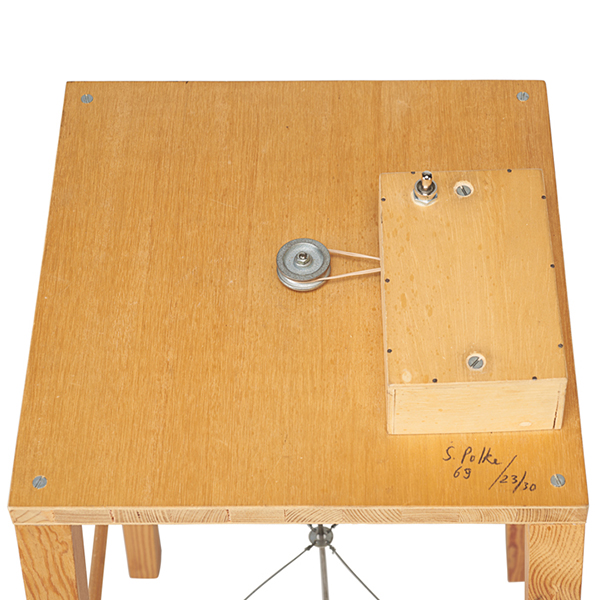Sigmar Polke and the Potato
https://www.bidsquare.com/collection/artist/gerhard-richter-707Behold, the potato.
Considered one of the most ubiquitous foods in the world, the potato has been identified as a symbol of sustenance and prosperity for hundreds of years, often by cultures far from its ancestral home in the Andean mountains. Some historians even credit the likable round vegetable for the rise of European empires in laying the groundwork for modern industrial agriculture and for providing a staple on the plate of global survival. After all, without the arrival of the starchy spud in the West, feeding rapidly growing populations might not have been possible.

For example, because potatoes provide relative nutritional value and can replace meat in a main meal, the poor and labor classes of Europe began planting them for their own consumption, as well as for livestock feed. The dependability for and the expansion of the crop in Ireland became so extreme by the 19th century that the spread of "potato blight" (a parasitic virus) between 1845 and 1849 became the culprit for over one million deaths and nearly one million more emigrates. Commonly known as the Irish Potato Famine, only two-thirds of the normal harvest was available for nearly three million dependent Irish citizens. The massive absence of potatoes not only created a catastrophic fit of starvation, but it also permanently changed Ireland's population demographics. Similarly, potatoes have also been mashed up in wartime conspiracies. In 1950 the East German government claimed that American planes released swarms of villainous potato beetles over their fields to purposefully sabotage crops. The devastation, which was likely due to a lack of pesticides, motivated East German propaganda. During the Cold War you could find reams of posters illustrating the arrival of the evil potato beetle, brought fourth by Yankee enemies. However, when potatoes weren't under attack by an invasive species or being ravished by paranoia, it rolled along quite efficiently to keep feeding the masses.
For one man, the potato was regarded as such an ingenious gift to mankind that he sought to elevate it from its mundane service as "a poor mans meal" into a baffling fine art material. An artist of the postwar generation, Sigmar Polke was best known for his deliberate critique of the role of the artist in the modern world. His unusual perspective and unconventional use of materials was an approach fueled by skepticism. Sigmar constantly questioned systematic authority (fine art included) due to his upbringing in postwar Germany, which lead him to steep his work in a strong blend of historical and sociological observation. His experimentations in painting, photography, video and sculpture are unsurpassed in material variety. From the onset of his career in 1963 until his passing in 2010, Sigmar Polke did not settle comfortably into one style or one material; toxic chemicals, snail juice, uranium, bubble wrap and meteor dust were all a part of his palette. He flirted with the concepts and techniques found in the works of Pop Art artists such as Andy Warhol and Roy Lichtenstein as well as Neo-Dada titan Robert Rauschenberg and Fluxus eccentric, Joseph Beuys. However, Sigmar had complex processes all his own and developed unusual affections for materials that provided time-based reactions. He truly was a secret alchemist; which brings us back to the magical potato.
Coming up in Rago's Post War and Contemporary Art Auction on November 10th is a supreme example of Sigmar Polke's unique approach to art making. Offered as Lot 768, Sigmar Polke, Apparat, mit dem eine Kartoffel eine andere umkreisen kann (Apparatus Whereby One Potato Can Orbit Another), 1968, this sculpture has been featured along side his other potato-based works in important museum exhibitions such as "Alibis: Sigmar Polke 1963-2010", a retrospective show at the Museum of Modern Art in New York, and highlights the humorous yet intellectual strengths to be learnt from Polkes's portfolio. So, "why?" you might ask, would someone want to watch one potato orbit around another? And, what is it trying to say?
.jpg)
Portrait of artist, Sigmar Polke
Sigmar Polke experienced World War II first hand as a child leaving his birthplace, the German town of Oels (which is now Oleśnica in southern Poland) for East Germany in 1945. Only eight years later, the 12-year-old Sigmar and his family fled from the Soviets in the East to seek safety in West. Although they gained freedom, his family had lost everything, and unlike the communist East, the advertisements, foodstuffs and cultures that were allowed to flourish in The Federal Republic of Germany would be introduced to young Sigmar - this included American Pop Art. It is also worth mentioning that potatoes most definitely played a vital role in his childhood cuisine.

Chocolate Painting (1964)
In 1961, Sigmar Polke enrolled at the Düsseldorf State Art Academy. It was here that his teacher, Joseph Beuys, would try to impress his outlandish and poetic manifestos unto Polke, but in the end, Beuys was unable to completely sway him to follow in his footsteps. Instead, the befriending of fellow student Gerhard Richter is what really began to shape Polke's artistic discourse. Together they formed a movement called Capitalist Realism seen as a German form of Pop Art mainly because it focused on mass media and the banal. However, the pivotal difference lay in politics and not economics. Being that it was founded in Cold War Berlin, Polke and Richter pointed out the division between the Eastern block's Socialist Realism, which focused strictly on nationalism, with their Capitalist Realism, which represented the exposure of pop culture commodities and commercialism on the west side of Germany. One of the best-known artworks of Polke's that steamed directly from this movement was, Chocolate Painting (1964). In this early work, one notices an obvious nod to Andy Warhol's pop style, but something is missing. Unlike the upbeat, colorful brand names that dominated Warhol's prints, like Campbell's Soup and Brillo, Polke's lack of branding, given the blank wrapper and partially eaten product, leaves the viewer with a rather monotonous outlook on mass production.

Sigmar Polke, Potato House (Kartoffelhaus), 1967, painted wooden lattice and potatoes | Photo: Installation view at Migros Museum Für GegenwartskunstSstefan Altenburger Photography Zurich
By 1967, Polke and Richter had diverged to practice their concepts and skills separately. Polke, finally blossoming into a total anarchist, erected his second most famous work called Potato House (Kartoffelhaus). Firstly, this work challenged the sterile idea upheld by art institutions that mandates sculptures not be touched (or entered). As seen above, the wide opened wall serves as an open invitation. Secondly, the work, which is essentially a lean-to made of wooden lattice grids, is braced by hundreds of medium sized potatoes. Oddly, his choice to use potatoes adds a reliable looking weight to the house's otherwise flimsy construction - that is, before they begin to rot. As previously mentioned, Sigmar Polke appreciated alchemy; not only would the potatoes begin to decompose (causing museum curators to have to replace each and every one of them when exhibiting his works) but the act of puncturing and triggering the chemical breakdown of them brings up another point entirely. The potato is something to be admired in the realm of science as well. If boiled for eight minutes, cut into quarter-slices, and sandwiched between a copper cathode and a zinc anode that's connected by a wire, potatoes can provide LED-powered lighting for a room for as long as 40 days. As far as electrical conductors are concerned, this sturdy starch is basically nature's version of battery acid. This kind of inexpensive, clean energy could potentically power entire villages in underdeveloped and remote regions. When commenting on his Potato House (1967), the rather punkish artist explained that it was a shelter for 'the dissident dweller' - those who oppose authority and social constructs can truly have a vantage point with a garden like fence and the brilliant potato anchoring them in their alternate reality. Also, he might have chuckled at the idea of potentially stinking up a museum.
Considering the context of Sigmar Polke's life experiences and his preference for unconventional materials, it's no wonder why he embraced the tuber. Fit with a natural ability to power lights, sprout new tendrils and feed the world, it really should be appreciated more. On his love for the potato he said, “If there is anything at all that manifests everything artists are supposed to be or have - the delight in innovation, creativity, spontaneity, productivity, creating entirely out of oneself and so on - then it is the potato."
Located on the top of Lot 768, Apparat, mit dem eine Kartoffel eine andere umkreisen kann (Apparatus Whereby One Potato Can Orbit Another),1968 - or simply the "potato machine" - is a button. Once pressed, the sculpture will power on and begin rotating the central wire. The idea is to put one potato at the end of this curved wire and another on the floor directly underneath. The potato machine will then activate the potato orbit as if to simulate the electrical powers held within the potato, as well as worshiping the vegetable all in one shot. It is a bewildering concept that becomes more and more charming as we reflect on all of the other things we choose to revolve our lives around. Sigmar Polke presents us with a curious little concept that can really be cooked down and played with.
Click here to view full details for Lot 768, Sigmar Polke, Apparat, mit dem eine Kartoffel eine andere umkreisen kann (Apparatus Whereby One Potato Can Orbit Another),1968. Potatoes not included.
Click here to view all upcoming works by Sigmar Polke.
Don't have a Bidsquare account? Sign up here!

Jessica Helen Weinberg | Senior Content Editor at Bidsquare
Be in the know about upcoming auctions and exciting post-sale results by following us on Facebook and Instagram.
- Artist Spotlight: David Gerstein, Sculptural Pop in Bold Color & Motion
- The History of Rolex Watches: Innovation, Precision, and Enduring Prestige
- Preview the December Doyle+Design Auction: A Celebration of Modern & Contemporary Mastery
- Billings Winter Design 2025: A Celebration of Modern Mastery Across Eras
- The Ultimate Holiday Gift Guide: Luxe Finds From Bidsquare’s Finest Auctions
- Fine & Antique Jewelry Sale: A Curated Journey Through Craftsmanship & Design
- Upcoming Auction Spotlight: Doyle’s Fine Art: 19th Century & Early Modernism
- Entertain with Style This Holiday Season: Highlights from Doyle’s December 8 Auction
- Six Standout Lots from Newel’s Fine Jewelry, Timepieces & Luxury Handbags Sale
- Artist Spotlight: Roy Lichtenstein, Pop Art’s Master of Bold Lines & Bigger Ideas



 EUR
EUR CAD
CAD AUD
AUD GBP
GBP MXN
MXN HKD
HKD CNY
CNY MYR
MYR SEK
SEK SGD
SGD CHF
CHF THB
THB














